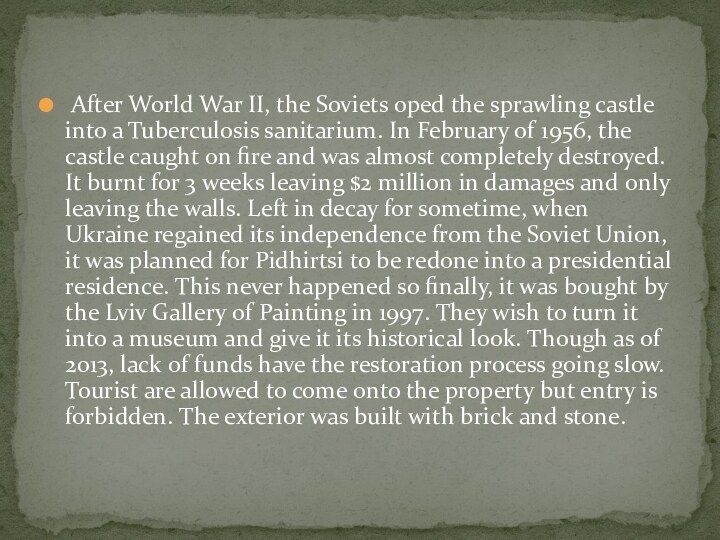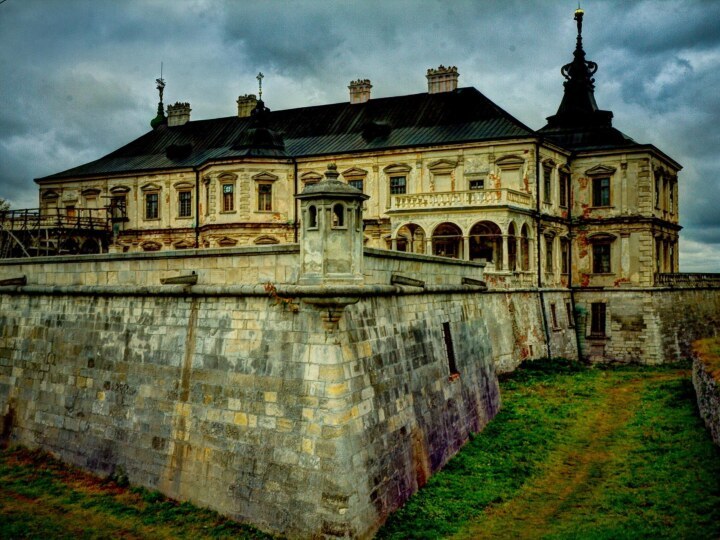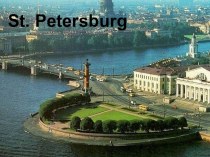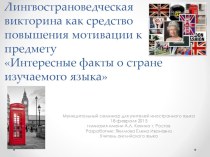- Главная
- Разное
- Бизнес и предпринимательство
- Образование
- Развлечения
- Государство
- Спорт
- Графика
- Культурология
- Еда и кулинария
- Лингвистика
- Религиоведение
- Черчение
- Физкультура
- ИЗО
- Психология
- Социология
- Английский язык
- Астрономия
- Алгебра
- Биология
- География
- Геометрия
- Детские презентации
- Информатика
- История
- Литература
- Маркетинг
- Математика
- Медицина
- Менеджмент
- Музыка
- МХК
- Немецкий язык
- ОБЖ
- Обществознание
- Окружающий мир
- Педагогика
- Русский язык
- Технология
- Физика
- Философия
- Химия
- Шаблоны, картинки для презентаций
- Экология
- Экономика
- Юриспруденция
Что такое findslide.org?
FindSlide.org - это сайт презентаций, докладов, шаблонов в формате PowerPoint.
Обратная связь
Email: Нажмите что бы посмотреть
Презентация на тему Pidhirtsi
Содержание
- 2. Pidhirtsi Castle (Ukrainian: Підгорецький замок; Polish: zamek
- 3. It was constructed by Guillaume Le Vasseur
- 4. The structure, built with brick and stone,
- 5. The castle takes the form of an
- 6. Beginning sometime in 1914 during the World
- 7. After World War II, the Soviets
- 8. There was also a library, the
- 13. Church of Saint Joseph in Pidhirtsi
- 16. Скачать презентацию
- 17. Похожие презентации
Pidhirtsi Castle (Ukrainian: Підгорецький замок; Polish: zamek w Podhorcach) is a residential castle-fortress located in the village of Pidhirtsi in Lviv Oblast (province) western Ukraine, located eighty kilometers east of Lviv.
















Слайд 3 It was constructed by Guillaume Le Vasseur de
Beauplan between 1635–1640 by order of the Polish-Lithuanian Commonwealth's
Grand Crown Hetman Stanisław Koniecpolski, on the place of the older fortress. The castle was then part of the Kingdom of Poland and it is regarded as the most valuable of palace-garden complexes in the eastern borderlands of the former Polish-Lithuanian Commonwealth.Слайд 4 The structure, built with brick and stone, was
designed in the characteristic palazzo in fortezza style. It
is located on the northern side of the Woroniaki hills, standing at 399 meters above sea level, overlooking the Styr River valley, in a prominent location where it can be seen from great distances. The palace itself is built into the slope of the hill. In the 17th century, it was surrounded by vineyards and Italian-style paterre gardens, its wine celebrated by the poetry of Jakub Sobieski and Andrzej Morsztyn. Guarded by a moat and drawbridge, fortified walls with bastions and a set of iron cannons .Слайд 5 The castle takes the form of an open
square nearly 100 meters on a side, with three
floors.Its western part served as an official residency for guests; the eastern range was private, reserved for the owner and servants. Above the entrance gate, a marble plaque to this day bears a Latin inscription: "A crown of military labours is victory, victory is a triumph, triumph is rest." There also was a grange, a private zoo, vineyards, an apiary, a trout pond and a mill.





























